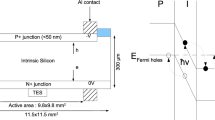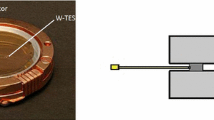Abstract
There is a common need in astroparticle experiments such as direct dark matter detection, double-beta decay without emission of neutrinos [\(0 \nu \beta \beta \)] and coherent neutrino nucleus scattering experiments for light detectors with a very low energy threshold. By employing the Neganov–Trofimov–Luke Effect, the thermal signal of particle interactions in a semiconductor absorber operated at cryogenic temperatures can be amplified by drifting the photogenerated electrons and holes in an electric field. This technology is not used in current experiments, in particular because of a reduction of the signal amplitude with time which is due to trapping of the charges within the absorber. We present here the first results of a novel type of Neganov–Trofimov–Luke Effect light detector with an electric field configuration designed to improve the charge collection within the semiconductor.




Similar content being viewed by others
References
B. Neganov, V. Trofimov, Otkryt. Izobret. 146, 215 (1985)
P.N. Luke, Voltage-assisted calorimetric ionization detector. J. Appl. Phys. 64, 6858 (1988)
M.P. Chapellier, G. Chardin, L. Miramonti, X.F. Navick, Physical interpretation of the Neganov–Trofimov–Luke and related effects. Physica B 284–288, 2135–2136 (2000)
M.P. Chapellier, Fancy ideas on Neganov–Trofimov–Luke effect (NTL) or: is there a limit to the NTL amplification? J. Low Temp. Phys. 237–242, 178 (2015)
CUORE Collaboration, Initial performance of the CUORE-0 experiment. Eur. Phys. J. C 74(8), 2956 (2014)
G. Angloher et al., Commissioning run of the CRESST-II dark matter search. Astropart. Phys. 31, 270 (2009)
J.H. Davis, The past and future of light dark matter direct detection. Int. J. Mod. Phys. A 30, 15 (2015)
The CRESST collaboration, Results on light dark matter particles with a low-threshold CRESST-II detector. Eur. Phys. J. C 75 (2015)
K.P. O’Donnell, X. Chen, Temperature dependence of the semiconductor band gaps. Appl. Phys. Lett. 58, 2924 (1991)
M. Stark et al., Application of the Neganov–Trofimov–Luke effect to low-threshold light detectors. Nucl. Instrum. Methods. Phys. Res. A 545, 738 (2005)
R.H. Kingston, J. Appl. Phys. 27, 101 (1956)
C. Isaila et al., Low-temperature light detectors: Neganov–Trofimov–Luke amplification and calibration. Phys. Lett. B 716, 160 (2012)
G.F. Knoll, Radiation Detection and Measurement, 3rd edn. (Wiley, New York, 2000)
B.G. Lowe, Measurements of Fano factors in silicon and germanium in the low-energy X-ray region Nucl. Instrum. Methods. Phys. Res. A 339, 354 (1997)
Acknowledgments
This research was supported by the DFG cluster of excellence “Origin and Structure of the Universe” (http://www.universe-cluster.de).
Author information
Authors and Affiliations
Corresponding author
Rights and permissions
About this article
Cite this article
Defay, X., Mondragon, E., Willers, M. et al. Cryogenic Silicon Detectors with Implanted Contacts for the Detection of Visible Photons Using the Neganov–Trofimov–Luke Effect. J Low Temp Phys 184, 274–279 (2016). https://doi.org/10.1007/s10909-016-1534-8
Received:
Accepted:
Published:
Issue Date:
DOI: https://doi.org/10.1007/s10909-016-1534-8




